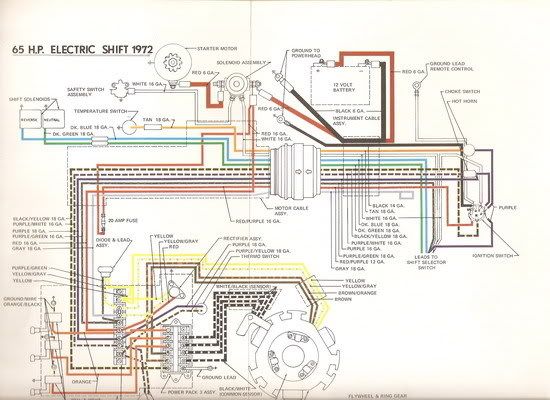Re: 1972 50hp Evinrude shift question
1972 would make it a hydro-electric shift and that's exactly what it should do. When the motor is running and you have the shift handle in neutral, one solenoid in the gearcase will be activated, and via a hydraulic/piston system, the clutch dog is disengaged. When you move the handle to reverse, both solenoids are energized and the clutch dog is engaged in the reverse position.
If you use the search function here in the forums, you will find a few threads on dealing with NLA shift switches. That said, you might find a functional control unit on one of the auction sites.
If you do go to a toggle, you will have to use two in order to replicate the neutral safety feature in the starter circuit. You also have to be very careful with a shift toggle, so you don't inadvertantly shift into reverse with high rpm on the motor.
I don't have a wiring diagram for your motor, but here's one (below) for a 1972 65hp Johnson. The shift circuitry should be the same.
One "peculiarity" of the shift circuitry that you should be aware of is the "diode and lead assembly." While the keyswitch is in the on position, the neutral circuit is energized by the battery or rectifier. When you turn the keyswitch off to shut the engine down, the power comes from the diode and lead assembly. If not for this fact, your gearbox would shift into forward the second you turn the key off.
To find it on your motor, look for a small ball on the starboard side that is brown. It will be near the electrical distribution block.
Be aware, also, that you can't use the type of gear lube that most gearboxes require. The hydro-electric gear boxes use a thinner lube that serves as a hydraulic fluid too. It used to be called "Type C," but is now referred to by BRP as Premium Blend. Just ask your local BRP deal for Type C oil, or tell them the year of your motor, and they will give you the correct equivalent.




















